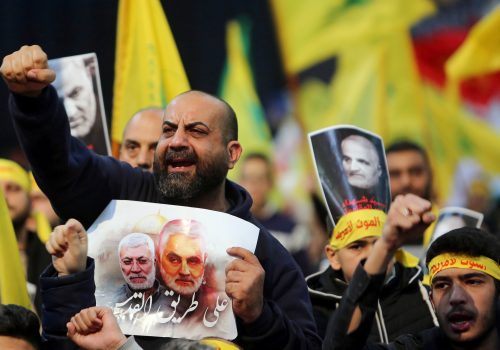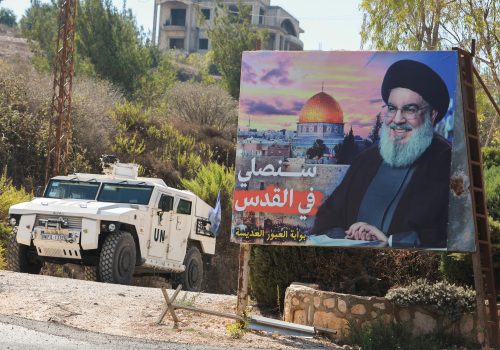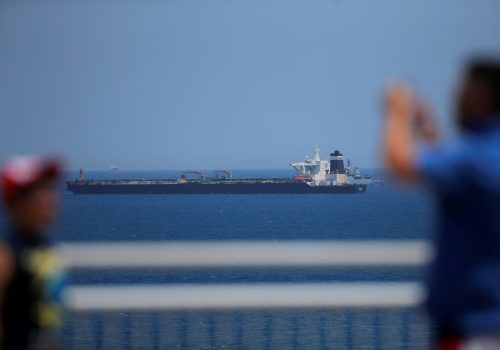Hezbollah and Iran have opened a fourth battlefront: Inside Israel
The Blue Line has been relatively calm since the 2006 conflict between Israel and Hezbollah—the deceptive quiet obscuring obsessive preparations for a future conflict both sides believe is inevitable. In furtherance of Iran’s regional strategy, the Shia organization has been establishing several frontlines—in south Lebanon, the Gaza Strip, and Syria—from which to fight the Jewish state directly and through allies. But with Israel’s attention seemingly focused exclusively on the group’s activities across its borders, Hezbollah appears to be establishing another front behind Israeli lines—both within the country’s official boundaries and the West Bank.
Prompted by Hezbollah’s recent brazen behavior, the Israeli security establishment seems fixated on detecting signals that indicate whether the group is readying for another direct war or security escalation with Israel. In March, Hezbollah deployed a thousand seemingly unarmed personnel along the border (four hundred were Hamas-affiliated Palestinians). Shortly afterward, the Shia organization facilitated two attacks against Israel but maintained a sufficient distance from their execution to avoid an Israeli reprisal or escalation. In late March, a Palestinian militant infiltrated from Lebanon and planted an explosive bearing the hallmark of Hezbollah manufacturing in Megiddo. Then, in early April, Hamas fired a barrage of thirty-four rockets from Lebanon into Israel.
Following this, Hezbollah staged a massive but relatively routine “war game” to commemorate Israel’s withdrawal from south Lebanon. On a smaller scale, it echoed Hezbollah’s ten thousand-man simulated invasion of the Galilee in August 2012, which commemorated its 2006 “victory” over Israel. This time, the group invited reporters to witness masked fighters training to destroy Israel by jumping through flaming hoops, firing from the backs of motorcycles, emerging through plumes of smoke, and blowing up Israeli flags posted on hills. The exhibition—useless as a battlefield exercise—was pure military theater intended to make headlines, produce images for Hezbollah’s martial music videos, and reinforce its supporters’ belief that Hezbollah can deter, defeat, and destroy Israel. It may also have covered Hezbollah’s infiltration of Israeli territory and installation of two outposts in Har Dov/Shebaa Farms—testing the limits of Israeli patience and gradually attempting to adjust the rules of engagement without incurring retaliation.
Critical as some developments may prove, they obscure a more dangerous Hezbollah initiative to establish a proxy foothold behind Israeli lines. Hezbollah has coveted such an option for decades, beginning—at least—after Israel expelled four hundred Hamas and Palestinian Islamic Jihad (PIJ) fighters to south Lebanon in 1992 and readmitted them a year later. These returnees served as a nucleus for Hezbollah and Iran to fight Israel from within—an effort that continued with direct armed assistance to Palestinian Leader Yasser Arafat’s Fatah (beginning in 1998), and then to several armed groups during the Second Intifada and afterward.
Since then, Hezbollah—working with Iran’s Islamic Revolution Guard Corps (IRGC) or separately—has spent considerable efforts to enlist Arab Israelis, Lebanese, nationals of Arab countries with foreign passports, and Palestinians to gather intelligence, recruit additional assets, or establish sleeper cells within Israel to plan terror attacks. To that end, the connections between Lebanese and Arab Israeli criminal networks have proven invaluable.
Statements from Hezbollah and Iranian officials—in addition to the group’s past and current behavior—betray a three-fold and ambitious objective that goes far beyond periodically igniting scattered chaos within Israel.
Part of Iran’s regional strategy is to develop its proxies’ domestic weapons production capabilities. The IRGC has achieved this outcome with Hezbollah in south Lebanon—relying on their Lebanese proxy—and with Yemen’s Houthis, as well as in the Gaza Strip. Sometime after the 2005 Israeli withdrawal and before his assassination in 2008, Hezbollah’s then-military commander Imad Mughniyeh spent months in the coastal enclave training Palestinian militants in rocket and launching pad production and tunnel and rocket warfare.
In line with that, Hezbollah and Iran appear set on replicating that outcome in the West Bank. IRGC Commander-in-Chief Hossein Salami admitted as much in 2022, saying Iran’s goal was to arm the West Bank “the same way that Gaza is armed.” As he told Fars News, “When something is homegrown, it cannot be stopped.” Recent attempts to fire rockets from Jenin on June 26—claimed by a Hamas-affiliated group calling itself the “[Yahya] Ayyash Detachment – West of Jenin”—and the discovery of a launch pad in June in east Jerusalem, as well as weapons laboratories on July 3 in Jenin, indicate these efforts may have begun producing results.
A second and corollary objective, per Salami in 2014, is to “imminently transform the West Bank into an unbearable inferno and hell” for Israel. Iran outsourced the task to Hezbollah, whose Unit 133 had been recruiting and funding cells in the West Bank through Secretary-General Hassan Nasrallah’s son, Jawad. According to Israeli police and the Shin Bet, Hezbollah’s continuous weapons smuggling into Israel and the West Bank has intensified significantly since 2021. This boost immediately preceded the ongoing upsurge of West Bank violence, which began in June 2021, with unrest spreading to cities long considered tranquil, such as Jericho.
As a result of these efforts, groups once thought defunct in the West Bank (ex. Hamas and Palestinian Islamic Jihad) or all across the region (ex. Al-Aqsa Martyrs Brigades (AAMB)) have experienced a resurgence. New armed groups have also sprung up, particularly in Jenin and Nablus. Fueled by coherent ideologies, some are affiliated with major organizations, like the PIJ Quds Brigades-linked Jenin Detachment and Nablus Detachment, and AAMB’s Hezam Al-Nar and Liwa al-Shuhada.
Others are motivated more by frustration, like the so-called Lion’s Den—a shadowy and diffuse entity centered in Nablus. This group emerged independently in August 2022, drawing on the disaffection of Palestinian youths through both the efficacy of the Palestinian Authority and negotiations with Israel. Here too, however, Iran has been fanning the flames. Shin Bet Director Ronen Bar recently noted that Tehran has been using online platforms to encourage recruitment, demonstrating the Islamic Republic’s exploitation of any available vector—ideological motivation or disillusionment—to stir up violence.
Finally, and perhaps most dangerously, Iran and Hezbollah have sought to exploit tensions between Arab and Jewish Israelis to establish what, in Resistance Axis jargon, has been called “the unification of the fronts.” To that end, Hezbollah’s Deputy Secretary-General Naim Qassem described Israel’s May 2021 inter-ethnic riots, which overlapped with the clash with Gaza-based Palestinian militants, as a “strategic change and historical inflection point.” West Bank, Gazan, and Jerusalemite Palestinians had become united with “’48 Arabs” in purpose, he said, whereby all Palestinians—not just the segment directly affected—would now collectively respond to any Israeli attack or encroachment.
Like Qassem, Hezbollah’s Executive Council Chairman Hashem Safieddine recently suggested that this development would allow the group to strike Israel from within. Fantasizing about the “united fronts” giving Hezbollah the ability to almost sow chaos at will within Israel, he said, “The day will come when the Resistance takes part in operations within [Israel’s] 1948 borders, something that Israel couldn’t imagine… this will cause the [Zionist] regime to crumble from within. Imagine what would happen if the Resistance enters the ‘48 territories.’ “
Establishing a front within Israel and the West Bank has immense utility for Hezbollah—now and during the group’s promised “comprehensive war” against the Jewish state. For now, it allows the group to continue bleeding Israel through proxies while maintaining plausible deniability. At a minimum, this will keep the IDF mired in combating low-level, albeit sustained, violence. At worst, Israel’s ongoing clashes with Palestinian militants increase the possibility of miscalculation or overreaction by one or both parties, potentially igniting a new intifada. Such an outcome appears increasingly plausible as a younger Palestinian generation—disillusioned both with their leadership and negotiations with Israel, and with no memory of the bloodiness of the Second Intifada—is increasingly skewing Palestinian society in support of returning to armed confrontation.
The future utility of Hezbollah’s “frontline” within Israel would come into effect during a war. Years into the future, Hezbollah could ignite that war during one of the religiously or nationalistically sensitive anniversaries cluttering the Israeli-Palestinian calendar. By timing a conflict to coincide with a period of heightened religious or nationalistic sentiment (on either or both the Palestinian and Jewish side), the group could activate the cells it has cultivated in the West Bank.
It could also tap affiliates among Arab Israeli criminal networks to carry out a nationalistically motivated attack on a Jewish target—a synagogue in a mixed Arab-Jewish Israeli city, for example. With this simple act, Hezbollah could exploit independently heightened inter-ethnic tensions to initiate a cycle of actions and reactions by Jewish and Arab extremists, just like in May 2021, which could spread to the rest of those communities and throughout the country. By creating disturbances on both sides of the Green Line, Hezbollah will force Israel to divert the attention of its government and security forces from other active fronts, including—most critically to the group’s survival—Lebanon, to confront a lethal threat behind its lines.
David Daoud is a nonresident fellow at the Atlantic Council.
Further reading
Thu, Apr 30, 2020
Hezbollah considers the United States, not Israel, its greatest enemy
IranSource By
The Open Letter, Hezbollah's manifesto, reserves its highest level of opprobrium for America, labeling it the main root of evil and declaring the “confrontation with America” as the yardstick for all of Hezbollah’s other activities.
Wed, Apr 5, 2023
A series of unrelated events happened in Israel. Fingers are pointing at Hezbollah.
IranSource By David Daoud
Tensions have been unusually high along the Lebanese-Israeli border. But war, or a large-scale conflagration, is not imminent.
Mon, Mar 13, 2023
Iran is still exporting oil to Hezbollah and the Assad regime. It’s using Syrian ports for transit.
IranSource By
Despite sanctions imposed on both countries, Tehran has continued to use Syrian ports as the main gateway to supply oil to its Lebanese proxy, Hezbollah, and its ally, the Bashar al-Assad regime.
Image: Iranian Foreign Minister Hossein Amirabdollahian gestures as he stands next to Hezbollah officials during his visit to Maroun Al-Ras village near the border between Lebanon and Israel, Lebanon April 28, 2023. REUTERS/Aziz Taher


